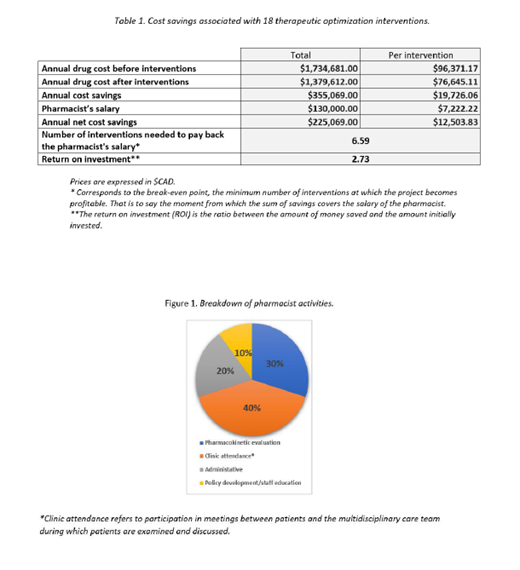Abstract
Context
Prophylactic treatment with coagulation factors in patients with hemophilia A and B is associated with significant costs to the health care system. Whether recombinant or plasma-derived therapies, factors are expensive products that follow complicated pharmacokinetic (PK) trajectories and are subject to tremendous inter-individual variation, making their efficient use challenging.
Effective management of these products therefore requires tailoring treatment to the patient. To do so, it is essential to systematically assess and interpret the PK profiles of patients. A dedicated pharmacist could greatly assist this process by standardizing the approach and assisting with interpretation. In Canada, pharmacists are not currently part of the comprehensive care team for the hemophilia population.
Aim
The purpose of this pilot project was to determine whether employment of a pharmacist as part of the Hemophilia Treatment Centre (HTC) would be an effective strategy to reduce costs associated with clotting factor prophylaxis regimens and identify the pharmacist's activities associated with this new role.
Methods
This project occurred at the Children's Hospital of Eastern Ontario (CHEO), Ottawa, Canada, a tertiary pediatric hospital serving 500,000 children and youth. A cost-minimization analysis was conducted to compare the pre-intervention strategy, current model of care without pharmacist involvement, to the post-intervention strategy, model of care that included a pharmacist in the HTC. The analysis was performed from the perspective of the formulary manager, Canadian Blood Services, with a 1-year time horizon.
The pharmacist was assigned for the period of 1-year including a 3-month phase-in period during which no interventions were done by the pharmacist, followed by 9 months of specific action on optimization protocols with the goal of achieving cost savings while maintaining best patient care. McMaster's Web-Accessible Population Pharmacokinetic Service (WAPPS-Hemo), which generates PK profiles, served as the basis for therapeutic optimizations. CHEO patients with moderate to severe hemophilia A or B or von Willebrand disease (vWD) receiving prophylactic treatment with recombinant or plasma-derived clotting factor were eligible for a pharmacist assessment.
Results
The pharmacist performed 18 therapeutic optimizations on 14 patients with moderate to severe hemophilia A or B, and 1 von Willebrand patient, aged 3 to 18 years old. As a result of the pharmacist's intervention (Table 1), clotting factor treatment costs for these patients extrapolated over one year were reduced by 20.5%. This represents a net savings of $225K CAD/year, or $12.5K CAD/optimization/year.
The pharmacist not only conducted the PK analyses but also participated in clinics, performed administrative activities, developed practice improvement policies and trained staff (Figure 1). Clinic attendance activities included discussions with families, education on new product administration, and discussions with the multidisciplinary team. Administrative activities consisted of organizing appropriate switch days, coordinating laboratory tests and timing of PK assessments, ensuring entire supply consumption, adverse event reporting and inventory management support.
Additionally, a sub-analysis showed that the pharmacist's interventions did not worsen annual bleed rates (ABR). In most cases, the ABRs were improved after their therapy was optimized using pharmacokinetics.
Conclusion
Substitution of clotting factor products and reduction of doses undertaken by the pharmacist resulted in significant savings. To date, no increase in bleeding frequencies have been observed in patients with optimized therapy, suggesting that patient outcomes are maintained. Thus, our project demonstrated that the addition of a pharmacist to the HTC to manage recombinant and plasma-derived coagulation factors can optimise the treatment plan and significantly reduce the costs of managing patients with hemophilia.
Following the success of this pilot project, Canadian Blood Services will provide additional funding to extend the project and expand its scope to include adult hemophilia patients. If the findings in this project continue to be demonstrated, this will be used as a case study to expand to all HTC across Canada.
Klaassen: Agios Pharmaceuticals: Consultancy; Amgen: Membership on an entity's Board of Directors or advisory committees; Hoffman-La Roche: Consultancy; Novo Nordisk: Consultancy; Octapharma AG: Consultancy; Sanofi: Consultancy; Takeda: Consultancy.


